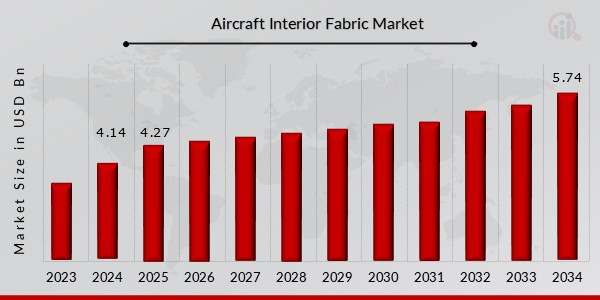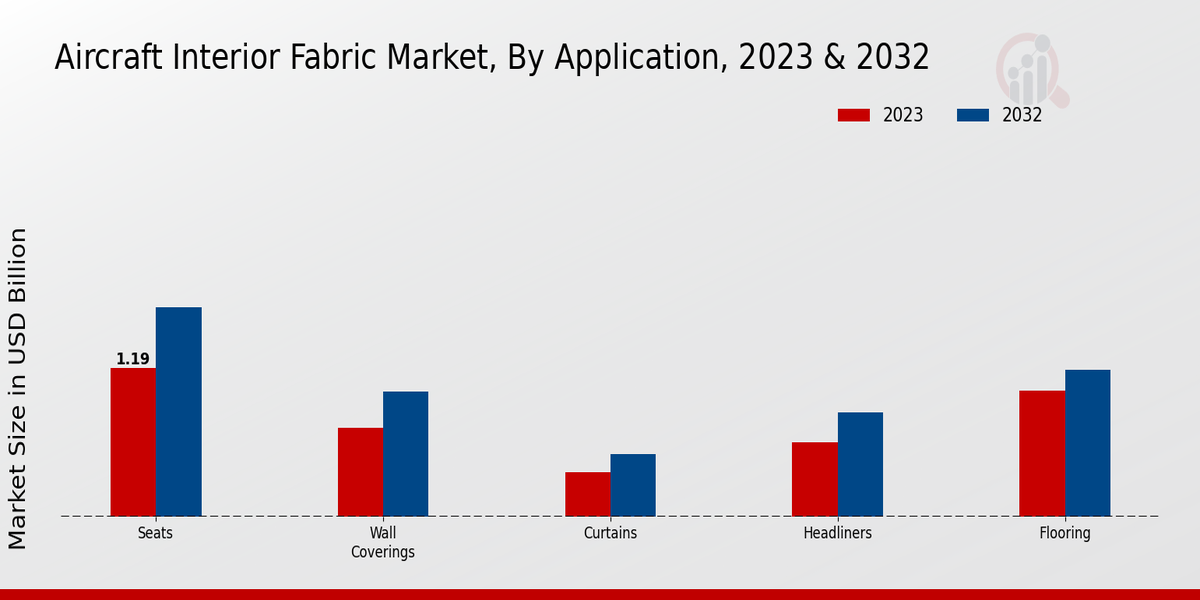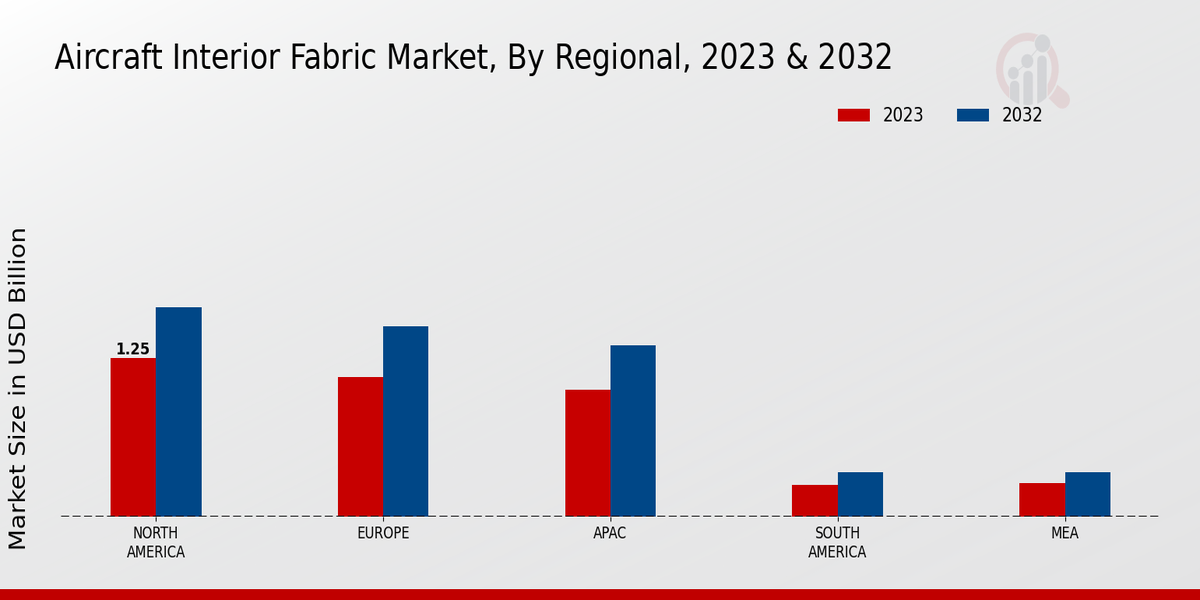Global Aircraft Interior Fabric Market Overview
The Aircraft Interior Fabric Market Size was estimated at 4.14 (USD Billion) in 2024. The Air4craft Interior Fabric Industry is expected to grow from 4.27 (USD Billion) in 2025 to 5.74 (USD Billion) by 2034. The Aircraft Interior Fabric Market CAGR (growth rate) is expected to be around 3.3% during the forecast period (2025 - 2034).
Key Aircraft Interior Fabric Market Trends Highlighted
The Aircraft Interior Fabric Market is experiencing significant growth driven by rising passenger air travel and an increasing focus on passenger comfort and aesthetics. Airlines are increasingly investing in high-quality, lightweight materials that enhance both the look and feel of their cabin interiors. The demand for environmentally friendly and sustainable fabrics is also on the rise, as companies aim to reduce their carbon footprint and appeal to environmentally conscious consumers. Customizability is becoming more important, with airlines seeking fabrics that can be tailored to match their branding and design preferences.
Opportunities within this market are being shaped by advancements in textile technology and an increasing trend towards personalized travel experiences.As airlines modernize their fleets, there is a chance to introduce innovative materials that provide better durability and maintenance options. The growing interest in premium economy sections presents an additional opportunity for fabric suppliers to create distinct product lines that cater to this segment.
Furthermore, partnerships between fabric manufacturers and aircraft manufacturers can lead to the development of unique fabric solutions for new aircraft models, supporting both innovation and differentiation in a competitive marketplace. Trends in recent times show a shift towards multifunctional fabrics that offer properties such as stain resistance, fire retardancy, and antimicrobial capabilities.There is also a notable inclination towards using fabrics that enhance the overall passenger experience by optimizing acoustics and providing a sense of luxury. Digital printing technologies are becoming more prevalent, allowing for intricate designs and branding directly into fabrics.
As sustainability and technology converge, the landscape of the aircraft interior fabric market is evolving, paving the way for new materials that will redefine air travel comfort in the years to come.

Source: Primary Research, Secondary Research, Market Research Future Database and Analyst Review
Aircraft Interior Fabric Market Drivers
Growing Demand for Lightweight Materials
The Aircraft Interior Fabric Market Industry is experiencing a significant shift towards the adoption of lightweight materials. This trend is primarily driven by the aerospace sector's ongoing efforts to enhance fuel efficiency and reduce emissions. With the rising costs of aviation fuel, airlines are increasingly focusing on operating more economical aircraft. Lightweight fabrics contribute to overall weight reduction, leading to lower fuel consumption and operating costs.As aircraft manufacturers and airlines continue to prioritize sustainability and operational efficiency, the demand for lightweight interior fabrics will rise.
This shift not only supports the economic goals of airlines but also aligns with their commitments to environmental sustainability. Consequently, the growth of the Aircraft Interior Fabric Market can be directly linked to the ongoing innovations and developments in lightweight material technologies, prompting industry players to invest in research and development to create advanced fabric solutions.The increased competition among manufacturers to provide superior lightweight options is expected to propel the market forward, contributing to a healthier growth trajectory in the years to come.
This trend aligns with the broader aviation industry's movements towards green technologies and sustainable construction practices, ensuring that the market remains robust and dynamic. As airlines continue to modernize their fleets with an eye towards efficiency, the demand for innovative and lightweight interior fabrics will play a crucial role in shaping the future of aircraft design and passenger comfort.
Increasing Air Travel and Aircraft Demand
The Aircraft Interior Fabric Market Industry is significantly driven by the rapid increase in air travel and the corresponding rise in aircraft demand. As more individuals seek to fly for both personal and business reasons, airlines are expanding their fleets to accommodate this growth. This surge in air travel has led to a greater need for high-quality interior fabrics that provide comfort, aesthetic appeal, and durability.
Airlines are recognizing that the passenger experience is paramount and are thus investing in better interior materials to enhance the overall travel experience.New aircraft orders and existing fleets with advanced interior fabric options are common practices as airlines strive to meet customer expectations while enhancing their brand identity. This growing demand for air travel paves the way for a parallel increase in the Aircraft Interior Fabric Market, making it a significant driver of market growth.
Technological Advancements in Fabric Manufacturing
The Aircraft Interior Fabric Market Industry benefits greatly from ongoing technological advancements in fabric manufacturing. Innovations such as the development of new synthetic materials, enhanced durability features, and superior fire resistance are reshaping the landscape of aircraft interiors. Manufacturers are continuously exploring advanced techniques like nanotechnology and smart textiles to create fabrics that not only meet safety standards but also enhance passenger comfort.These advancements lead to fabrics that are lighter, easier to maintain, and more aesthetically versatile, ultimately answering the needs of both airlines and passengers.
As technology continues to evolve, the market for aircraft interior fabrics will be positively impacted, driving growth.
Aircraft Interior Fabric Market Segment Insights
Aircraft Interior Fabric Market Application Insights
The Aircraft Interior Fabric Market encompasses various applications that significantly contribute to its overall revenue generation. In 2023, the market is expected to be valued at 3.87 USD Billion, with a progressive growth trajectory anticipated through 2032. Within this market, the application segments include Seats, Wall Coverings, Curtains, Headliners, and Flooring. The Seats category holds majority holding with a valuation of 1.192 USD Billion in 2023, projected to rise to 1.677 USD Billion by 2032.
This segment is fundamental as it influences passenger comfort and aesthetic appeal, making it a priority in aircraft design and refurbishment.Wall Coverings represent another significant segment, valued at 0.715 USD Billion in 2023, with growth estimates reaching 1.006 USD Billion by 2032, reflecting the increasing focus on enhancing interior environments and insulating properties. The Curtains segment, although smaller in comparison, holds a valuation of 0.358 USD Billion in 2023 with a rise to 0.503 USD Billion by 2032, emphasizing the importance of privacy and light control in cabin areas.
Headliners, valued at 0.596 USD Billion in 2023 and projected to increase to 0.839 USD Billion by 2032, play a crucial role in creating a welcoming atmosphere and contributing to noise reduction within the aircraft.Lastly, the Flooring segment, valued at 1.009 USD Billion in 2023 and expected to grow to 1.174 USD Billion by 2032, is vital for durability and safety within the cabin, influencing maintenance and overall passenger experience.
The expected market growth across these applications reflects trends towards enhancing passenger comfort, improving aircraft aesthetics, and adhering to safety regulations, even as the industry faces challenges such as fluctuating material costs and evolving design standards. The insights derived from the Aircraft Interior Fabric Market data demonstrate opportunities for innovation and sustainable practices within each application, driving the industry forward as it adapts to changing consumer preferences.

Source: Primary Research, Secondary Research, Market Research Future Database and Analyst Review
Aircraft Interior Fabric Market Material Type Insights
The Aircraft Interior Fabric Market revenue is projected to reach 3.87 billion in 2023, reflecting the significant role of various material types in driving market growth. This market is characterized by the use of Natural Fibers, Synthetic Fibers, and Blended Fabrics, which cater to diverse applications in aircraft interiors. Natural Fibers are gaining traction due to their lightweight properties and eco-friendliness, aligning with the industry's sustainability initiatives.
Synthetic Fibers continue to dominate the market owing to their durability, resistance to wear, and ease of maintenance, making them highly preferred in high-traffic areas of aircraft.Blended Fabrics are also emerging as important contributors, as they offer a versatile solution combining the benefits of both natural and synthetic materials, appealing to manufacturers looking for the ideal balance between performance and aesthetics. Additionally, the Aircraft Interior Fabric Market statistics suggest a steady increase in demand, bolstered by growth drivers such as rising air travel, advancements in textile technologies, and a growing emphasis on passenger comfort and airline branding.
However, challenges like fluctuating raw material costs and stringent regulatory standards regarding fire retardancy remain pertinent considerations in this evolving market landscape.
Aircraft Interior Fabric Market End Use Insights
The Aircraft Interior Fabric Market revenue is steadily increasing, with projected growth from 3.87 USD Billion in 2023 to 5.2 USD Billion by 2032. Within the End Use segment, various categories significantly contribute to this market's dynamics, including Commercial Aircraft, Military Aircraft, and Private Jets. The Commercial Aircraft category holds a substantial portion of the market due to the rising demand for air travel and the need for enhanced passenger comfort and aesthetics.
Military Aircraft, while smaller in share, plays a critical role because of specific requirements for durability and functionality in challenging environments.Private Jets also represent a noteworthy segment, driven by a growing trend of personalized luxury travel, requiring high-quality fabrics that provide both comfort and style. Collectively, these categories reflect the evolving demands and preferences of different user bases, showing an upward trajectory in the overall Aircraft Interior Fabric Market statistics.
Factors such as technological advancements in material manufacturing, increased travel activities, and a focus on sustainable and lightweight materials are acting as key drivers for this growth, while challenges like fluctuating raw material prices and competitive pressures persist in the industry.
Aircraft Interior Fabric Market Fabric Properties Insights
The Aircraft Interior Fabric Market is valued at 3.87 USD Billion in 2023 and is projected to experience significant growth, driven by increasing demand for durable and innovative fabric technologies. In this market segment, Fabric Properties such as flame retardant, water resistant, stain resistant, and lightweight features play a critical role in enhancing the safety, usability, and aesthetic appeal of aircraft interiors.
Flame retardant fabrics are crucial for ensuring passenger safety during air travel, while water resistant fabrics enhance the longevity and maintenance of aircraft interiors.Stain resistant fabrics contribute to a clean, professional appearance, thus catering to airlines' desire for an appealing cabin environment. Furthermore, lightweight fabrics are becoming increasingly significant, as they contribute to fuel efficiency and overall aircraft performance. Together, these fabric properties not only address the functional requirements of the industry but also align with current market trends focusing on sustainability and operational efficiency.
As the Aircraft Interior Fabric Market continues to evolve, these properties will play an essential role in meeting the growing needs of manufacturers and consumers alike, shaping the future landscape of the industry.
Aircraft Interior Fabric Market Regional Insights
The Aircraft Interior Fabric Market is witnessing diverse growth across regional landscapes, with a total market valuation anticipated at 3.87 USD Billion in 2023 and expected to rise significantly over the coming years. North America dominates the market with a valuation of 1.25 USD Billion in 2023 and projected growth to 1.65 USD Billion in 2032, showcasing its major holding due to high aircraft manufacturing and consumer demand.
Europe follows closely, with its market valued at 1.1 USD Billion in 2023, driven by advanced aerospace technologies and a growing emphasis on comfort and design.The APAC region is also contributing significantly, valued at 1.0 USD Billion in 2023, as it captures growing air travel demand and rising disposable income among consumers. South America and the MEA regions hold smaller shares, valued at 0.25 USD Billion and 0.27 USD Billion respectively in 2023, yet they present opportunities for growth as the aviation sector expands.
Overall, the Aircraft Interior Fabric Market data indicates a vertical growth dynamic, reflecting strong market trends influenced by innovations and evolving passenger preferences.

Source: Primary Research, Secondary Research, Market Research Future Database and Analyst Review
Aircraft Interior Fabric Market Key Players and Competitive Insights
The Aircraft Interior Fabric Market is characterized by a dynamic competitive landscape, driven by requirements for enhanced safety, comfort, and aesthetics in the aerospace industry. Factors such as increasing air travel, growing passenger expectations, regulatory compliance regarding materials, and innovations in fabric technology are central to this market's evolution. Companies are focusing on providing lightweight, durable, and fire-resistant fabrics that not only meet stringent safety standards but also offer a variety of styles and finishes to cater to diverse customer preferences.
The competitive dynamics of the market reflect a blend of established players and emerging companies, all striving to capture market share through technological advancements, strategic partnerships, and sustainability initiatives.Rockwell Collins holds a strong position in the Aircraft Interior Fabric Market, leveraging its extensive experience and well-established reputation in the aerospace and defense sector. The company benefits from its comprehensive portfolio that includes advanced aerospace technologies and high-quality interior solutions tailored for commercial and military aircraft. Rockwell Collins is known for its commitment to innovation, particularly in integrating cutting-edge materials that enhance the efficacy and comfort of aircraft interiors.
Its focus on customer-centric designs has allowed it to develop lasting relationships with aircraft manufacturers and airlines, ensuring reliable supply chains and meeting industry demands effectively. The ability of Rockwell Collins to adapt to changing market needs and regulations, combined with their technical expertise in both design and production, contributes to their competitive advantage in the aircraft interior fabric space.DuPont possesses a significant presence in the Aircraft Interior Fabric Market, renowned for its pioneering advancements in materials science. The company's fabric offerings are distinguished by their exceptional performance characteristics, including flame resilience, durability, and maintenance ease, crucial for aircraft applications.
DuPont's longstanding commitment to research and development enables it to produce innovative textile solutions that align with evolving safety requirements and consumer preferences. Moreover, DuPont's reach and robust distribution networks allow it to effectively serve a wide array of clients, from commercial airlines to aircraft manufacturers, ensuring their products are accessible in key markets. The company prioritizes sustainability and environmental responsibility in its manufacturing processes, appealing to modern consumers and aligning with the aerospace industry's growing emphasis on eco-friendly practices. Through its reputation for quality and innovation, DuPont continues to be a formidable competitor within the aircraft interior fabric domain.
Key Companies in the Aircraft Interior Fabric Market Include
Aircraft Interior Fabric Market Industry Developments
Recent developments in the Aircraft Interior Fabric Market have shown significant advancements in material technology and sustainability efforts among leading companies such as Rockwell Collins, DuPont, and Safran. Notably, DuPont has introduced innovative textiles that enhance durability and meet stringent safety regulations. The market has also seen heightened competition with companies like Zodiac Aerospace and GKN Aerospace focusing on lightweight materials that improve fuel efficiency in aircraft. Current affairs point towards a growing trend in mergers and acquisitions, with firms recognizing the need for strategic partnerships to boost their product offerings and market share.
For instance, MRA Group's collaboration with Boeing aims to integrate advanced fabric technologies into commercial aircraft interiors. Additionally, there has been an observable increase in market valuation among these companies, driven by rising demand for premium and sustainable interior solutions. The ongoing emphasis on passenger comfort and safety continues to influence product development and market dynamics, with firms actively investing in research and development to align with evolving consumer preferences. This environment fosters innovation, ensuring that the future of aircraft interiors remains both stylish and functional.
Aircraft Interior Fabric Market Segmentation Insights
Aircraft Interior Fabric Market Application Outlook
Aircraft Interior Fabric Market Material Type Outlook
Aircraft Interior Fabric Market End Use Outlook
Aircraft Interior Fabric Market Fabric Properties Outlook
Aircraft Interior Fabric Market Regional Outlook
| Report Attribute/Metric |
Details |
| Market Size 2024 |
4.14 (USD Billion) |
| Market Size 2025 |
4.27(USD Billion) |
| Market Size 2034 |
5.7(USD Billion) |
| Compound Annual Growth Rate (CAGR) |
3.3% (2025 - 2034) |
| Report Coverage |
Revenue Forecast, Competitive Landscape, Growth Factors, and Trends |
| Base Year |
2024 |
| Market Forecast Period |
2025 - 2034 |
| Historical Data |
2020 - 2024 |
| Market Forecast Units |
USD Billion |
| Key Companies Profiled |
Rockwell Collins, DuPont, VSMPOAVISMA, Safran, MRA Group, Balkan Air, Zodiac Aerospace, Diehl Stiftung, Ramco, Airbus, Draexlmaier Group, Alenia Aermacchi, Trimcraft, Boeing, GKN Aerospace |
| Segments Covered |
Application, Material Type, End Use, Fabric Properties, Regional |
| Key Market Opportunities |
Sustainability-focused fabric innovation, Expanded supply chains in emerging markets, Rising demand for customized interiors, Increased aircraft fleet modernization, Enhanced passenger comfort features |
| Key Market Dynamics |
rising demand for lightweight materials, increasing aircraft production rates, stringent safety regulations, growing focus on aesthetics, advancements in fabric technology |
| Countries Covered |
North America, Europe, APAC, South America, MEA |
Frequently Asked Questions (FAQ):
The Aircraft Interior Fabric Market is expected to be valued at 5.74 USD Billion in 2034.
The expected CAGR for the Aircraft Interior Fabric Market from 2025 to 2034 is 3.3%.
North America is projected to have the highest market value at 1.65 USD Billion in 2032.
The estimated market value for Aircraft Interior Fabric applications in Seats is 1.677 USD Billion in 2032.
Major players in the Aircraft Interior Fabric Market include Rockwell Collins, DuPont, and Safran.
The expected market size for Wall Coverings in 2032 is 1.006 USD Billion.
The projected market size for Flooring applications is 1.174 USD Billion in 2032.
The Aircraft Interior Fabric Market is valued at 3.87 USD Billion in 2023.
The value of the Aircraft Interior Fabric Market in Europe is expected to be 1.5 USD Billion by 2032.
The estimated market value for Curtains applications is 0.503 USD Billion in 2032.
















